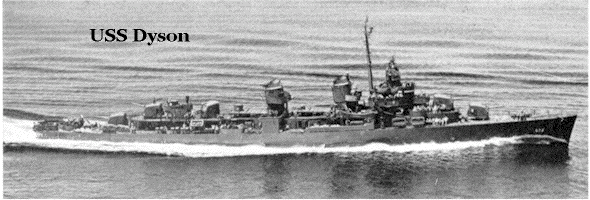 |
 |
History of the USS DYSON (DD-572)
USS DYSON (DD-572), joined the
fleet in 1943, having been built by the Consolidated Steel Corporation
at Orange, Texas. Her keel was laid there on 25. June 1941, and she was
launched on
15. April 1942. DYSON was first placed in commission on 30. December
1942,
when Commander Roy A. Gano, USN, assumed command.
The destroyer was named for the
late Rear Admiral Charles W. Dyson, USN, who was awarded the Navy Gross
for his service during World War I.
Transiting the Panama Canal on 21.
May, 1943, she steamed to Noumea, New Caledonia, via the Society
Islands. There she found escort duty awaiting for the USS SARATOGA and
the USS NORTH CAROLINA.
In October, 1943 the DYSON, in
company with the rest of the "Little Beaver" ships of Destroyer
Division 23, under the command of Capt. Arliegh A. Burke, was in action
in Empress Augusta
Bay.
After an initial collision course
torpedo attack, the quartet of destroyers set out in pursuit of the
enemy,
during which time one more ship was damaged and a FUBUKI class
destroyer
sunk.
Result of the brief engagement,
one cruiser and one destroyer sunk, many others damaged. Since the
battle of
Empress Augusta Bay had been fought in waters dominated by Japanese air
power,
an air attack was expected. Approximately 70 Rabaul-based planes
pounced
on the force at 0800, and made one pass before being driven off by the
withering anti-aircraft fire. Seventeen were downed in the first attack
with DYSON
claiming four. No one was injured.
On 25. November the squadron
intercepted six enemy destroyers. Pressing a surprise torpedo attack,
the enemy first became aware of their presence when the missiles hit
their targets, setting off two sets of explosions which cast a red glow
visible for miles. Two of
these six ships were sunk and the third was damaged so that it fell an
easy
victim later.
After taking on fuel and
ammunition the "Beavers" made an anti shipping sweep along the
Rabaui-Kavieng-Truk shipping lanes on 22. February. A small enemy
merchant ship was sighted during the patrol and soon sunk by the
combined fire of the group. Seventy-one survivors were rescued, with
DYSON taking aboard 31. That afternoon the group sighted a destroyer
minelayer and sank her in short order.
After a series of maneuvers and
exercises off Majuro DYSON was again steaming with the big carriers on
11. June when they flew strikes against Saipan and Pagan Islands,
Chichi Jima on the 15. June and Iwo Jima on the 16. June.
CHARLES AUSBURNE, CONVERSE,
CLAXTON and DYSON were all tied up in Washington Navy Yard on 19.
October, 1945 when, in an impressive ceremony, James Forrestal,
Secretary of the Navy, presented the squadron with the following
Presidential Unit Citation:
"For extraordinary heroism in action against enemy Japanese forces during the Solomon Islands Campaign, from November 1, 1943, to February 23.1944. Boldly penetrating submarine infested waters during a period when Japanese naval and air power was at its height, Destroyer Squadron Twenty-Three operated in daring defiance of repeated attacks by hostile air groups, closing the enemies strongly fortified shores to carry out sustained bombardments against Japanese coastal defenses and render effective cover and fire support for the major invasion Operations in this area. Commanded by forceful Leaders and manned by aggressive, fearless crews, the ships of Squadron Twenty-Three coordinated as a superb fighting team; they countered the enemies fierce aerial bombing attacks and destroyed or routed his planes, they intercepted his surface task forces, sank or damaged his warships by torpedo fire and prevented interference with our transports. The brilliant and heroic record achieved by Destroyer Squadron Twenty-Three is a distinctive tribute to the valiant fighting spirit of the individual units in this indomitable combat group and of each skilled and courageous ships company."Shortly afterward, the ship reported to the Atlantic Reserve Fleet, Charleston, South Carolina, where she went out of commission in reserve as of July 1953.